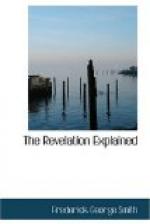Before considering the time-prophecy in this vision, we will pass on to notice a few particulars respecting the horses and their riders. The horsemen possessed breastplates of fire, jacinth, and brimstone; while out of the mouths of the horses proceeded fire, smoke, and brimstone. There is evidently a special design in distinguishing between the horses and their riders. These symbols, being drawn from different sources—the former from the natural world and the latter from human life—point out the two characteristics of the Turks as a politico-religious power. The symbolic description of the two is almost identical. The horsemen had breastplates of fire, jacinth (purplish or reddish blue), and brimstone. This describes the character of the Turks as a religious system. Out of the horses’ mouths proceeded fire, smoke, and brimstone, which represents the Moslems as a political power. The only difference is that the smoke is substituted for the jacinth, but they very nearly agree in color. We are thus brought to the conclusion that the political and the religious power of the Turks is in harmony and agreement with each other—united in the closest manner possible, like a horse and its rider, and both animated by the same spirit. That spirit is perhaps their fierce, fanatical, aggressive, intolerant character.
The tails of the horses were like serpents with heads, their power being in their mouth and in their tails—the one a lion, the other a serpent. It was by the fire, the smoke, and the brimstone that came from their lion-heads that the third part of men was killed, or their conquests were made; then with their serpent-like tails would they torment or “hurt” all those who would not adopt the Moslem faith, being in this respect like the scorpion locusts. Their lion-heads would denote their invincible strength and courage; and their serpent-tails, the tormenting sting inflicted upon those whom they subdued but who would not accept their religion. It is not said that the riders were the direct agents of destruction—not the Moslem faith as a religion—but it was the horses that accomplished the deadly work—the Ottomans as a political body. This was the power that extended conquests and established their empire, although it was accompanied by the religious system, working in perfect harmony.
It is said that the “rest of the men which were not killed by these plagues” repented not. This expression doubtless signifies the Western, or Latin, church. They saw these judgments of the Euphratean horsemen on the Eastern empire, and the triumph of the Moslem sword and faith (the woe fell as a judgment upon the Eastern church); still, they continued as before in their abominable idolatries, by which is probably meant their worship of the virgin Mary, saints, relics, and images. There was no reformation. Error, superstition, and ecclesiastical usurpation prevailed as before.




